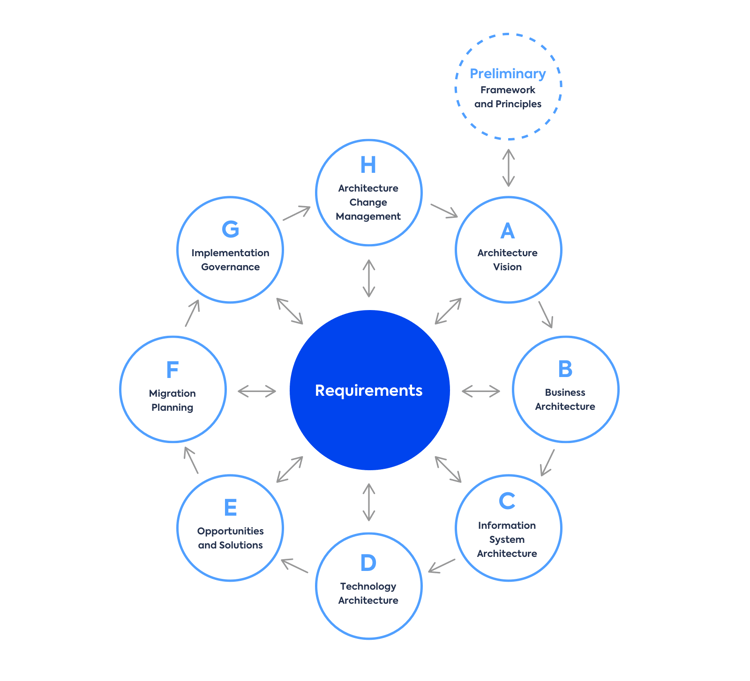What is TOGAF®? | The Definitive Guide to TOGAF® | LeanIX
The four architectural domains of TOGAF
TOGAF®’s ADM process is specifically designed to accelerate workflow across four domains of enterprise architecture:
- Business architecture
Responsible for mapping the relationships between a business’s operational hierarchies, policies, capabilities, and initiatives. - Applications architecture
Responsible for defining relevant applications to handle company data and the ways in which to implement and deploy these applications within the overall infrastructure. - Data architecture
Responsible for defining the rules and standards to store and integrate data. - Technical architecture
Defines platforms, service, and all surrounding technology components to serve as a reference for development teams.
The TOGAF Architecture Development Model (ADM)
The TOGAF framework not only outlines the key components of an Enterprise Architecture through its four Architectural Domains, but it also provides a clear roadmap for how to create that architecture. This roadmap is known as the Architecture Development Method (ADM), and it is a nine-phase sequential process. The ADM guides organizations in developing their Enterprise Architecture, and it is depicted in Figure 1.

Figure 1: TOGAF
®
Architecture Development Method
Throughout the nine stages of the TOGAF® ADM process, these four architectural domains become iteratively developed to create a balanced architecture capable of securing organizational changes. An industry-agnostic process, this method is intended to limit guesswork and foster maturity in enterprise architecture programs—all of which while amassing enterprise-specific architectural repositories to support future projects.
What are the challenges of TOGAF® in modern IT environments?
TOGAF® is currently in version 10, and with its evolving library of definitions and symbology comes the unavoidable struggle to align to the framework in an agile manner. Much of this is due to TOGAF®’s comprehensive architectural compliance review process, a checklist involving hundreds of items from categories such as information and systems management; hardware and operating systems; software services and middleware; applications (business, infrastructure, and integration specifications); and information management.
Yet, while compliance is an indispensable element of architectural governance, religiously adhering to the framework’s standards is a difficult task for any enterprise architecture program. As such, for modern organizations wishing to efficiently uphold TOGAF®’s best practices, it’s all but necessary to gain the participation of stakeholders throughout an organization in order to efficiently assess and catalog IT projects.
Agile and TOGAF® are indeed capable of co-existing, but in order for it to happen, collaborative pathways for standardizing IT entities among teams must be established.
What is new in TOGAF® 10?
The 10th Edition of TOGAF features a new modular format that brings several benefits. The Fundamental Content branch includes all the basics of the framework, making it easier for businesses to start implementing and learning TOGAF. This part of the framework is the least likely to change significantly over time. The modular structure provides enterprise architects with better guidance and a simpler navigation process, allowing them to effectively use the framework. The knowledge base and topic-specific guidance are separated into formal parts of the framework, making frequent releases of additional material possible while preserving stability in the fundamental content.
Furthermore, the 10th Edition of TOGAF continues to enhance its ability to support the fundamental aspects of business strategy, making it more useful for vendors to deliver new features and services to specialized market segments while adhering to open standards. The framework is designed to adapt to the changing business needs and is a living body of knowledge, allowing organizations to establish agile ways of working that continually evolve. The 10th Edition of TOGAF demonstrates how the framework is evolving to deliver value in times of change.















![Toni Kroos là ai? [ sự thật về tiểu sử đầy đủ Toni Kroos ]](https://evbn.org/wp-content/uploads/New-Project-6635-1671934592.jpg)


